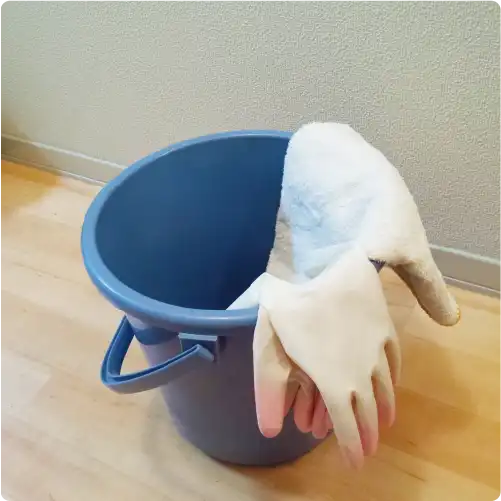- Company
- Products
- Technical report
- Indusrial cleaning
- Micro Joining and Assembly Technology
- Ultrasonic technology
- Trouble solution
- Cleaning
- Removing
- Attaching
- PCB Columns
Published on :
HAJIKI (cissing) is a phenomenon in which a flowable paint comes into contact with a factor substance having a lower surface tension than that of the paint, and the factor substance spreads by being pulled by the paint, and the film thickness of the part becomes thinner.
This phenomenon is similar to HAJIKI (cissing), uncured paint mist falls on the paint film and dissolves by the thinner in the paint film, causing the paint on the surface of the paint film to dissolve while being displaced.
In general, when painting injection-molded products made of resin, the condensing substances of the external mold releasing agent sprayed on during molding and the internal mold releasing agent contained in the resin pellet can be cited as the causative substances.
Paintable mold release agents are usually used as external mold release agents if it is going to be painted later.
The internal mold releasing agent is blended in advance with antistatic agents used for countermeasures against static electricity in the pellet so that the external mold releasing agent does not need to be used. These mold releasing agents do not generate HAJIKI (cissing) if they are sufficiently thinner and smaller than the thickness of the paint film, but they generate HAJIKI (cissing) if they are condensed into large aggregates.
When an external mold releasing agent is used in injection molding process, a large amount of mold releasing agent is often applied more carefully to complicated shape parts and edge parts than to flat parts in order to improve mold separation.
In addition, even if the mold is released using an internal mold releasing agent, a small amount of external mold releasing agent may be applied to the part where the mold release is poor only in the initial stage because the mold releasability is inferior in the startup of the injection molding machine or after cleaning of the mold.
These initial startup products and stored molded products may be splashed with external release agent mist, resulting in an error. It is recommended to check not only the painting process but also the injection molding process and storage process.
In order to remove dirt, dust, etc. adhering to the surface of resin injection molded products, when the surface of molded products is wiped and cleaned by cloth, sponge, etc. with IPA (isopropanol) or a wiping agent (thinner mixture), HAJIKI (cissing) like splash and stripe may appear on flat surface.
The spots where the splash HAJIKI (cissing) occurs coincide with the spots where the operator applied the cloth to the molded article and the spots where the cloth was stopped. In both of these areas, the wiping agent remains in like splash, and the dirt component is condensed more than in other areas, which makes it easier for the wiping agent to generate HAJIKI (cissing).
Multiple stripe HAJIKI (cissing) often appear on a flat surface. This is because too much wiping agent is infiltrated in the cloth, and the wiping agent dries with wiping stripes.
As described above, when the internal mold releasing agent and antistatic agent are kneaded in the resin in advance and the wiping agent remains on the resin surface without drying for a long time, these additives are extracted into the wiping agent, and are condensed together with drying to form HAJIKI (cissing) substances.
The cloth after infiltrating with the wiping agent must be squeezed hard, and cleaning must be performed without stopping the cloth on the surface of the molded article.
The wiping agent should be designed to spread easily and dry uniformly. Wiping agents should be reviewed if they do not spread and dry in splash state, leaving a watermark.
In addition, it is necessary to frequently replace the wiping agent so that the dirt concentration in the wiping agent does not become too high. Note that when using IPA in high humidity or when water is mixed into it by 15% or more (condensation water due to latent heat of evaporation), water remains when drying, and may be visually recognized as a watermark after coating and drying the paint.
For wiping cloths, the material, shape, and knitting of the fibers are also important, and should be selected after confirming the compatibility with the cleaning agent.
If the clothes in the molding department and the painting department are washed in the same washing machine and dryer, the mold release agent in the molding department may adhere to the clothes in the painting department.
In the vicinity of the painting environment, there are many substances that are used without knowing that they contain HAJIKI (cissing) substances and that have an impact on paint quality.
Silicone, a well-known causative substance of HAJIKI (cissing) in painting, is used in various products such as shoe-polishing creams, glass cleaners, anti-foaming agents, car waxes, heat-resistant greases, and edible oils. It is necessary to take countermeasures with understanding the use of silicone in these products.
If the following silicone remains attached to the body at the start of painting work, it may cause a HAJIKI (cissing) problem.
| Silicone in wax | Car waxing |
| Silicone in shoe polish cream | Leather shoe polishing |
| Silicone to improve combing | Hair styling |
| Silicone on the printing surface | Reading of magazines and flyers |
| Silicone in a glass cleaner | Cleaning offices and booth |
There is HAJIKI (cissing) that occurs only when direction of the wind is toward the painting site with gentle breeze, and it is not raining.
| Silicone for defoaming in frying oil | SEdible oils for frying in cafeterias and cooking rooms |
| Silicone in defoaming agent | Defoaming agent used for defoaming the cooling tower |
| Phenyl-silicone | Heat-resistant lubricating oil and grease used in high-temperature drying ovens and baking ovens. |
| Phenylsilicone used for heat-resistant lubrication | Waste oil heater |
| Silicone in the mold release agent | Aluminum die casting plant |
| Silicone for improving combing in hair-shaping spraying | Rest rooms and lavatories |
Reference: "Do not use hair-styling sprays in the vicinity of the oil fan heater" is because the silicone contained in the hair-styling agent burns and affects the flame sensor. It is also advisable to investigate the positional relationship between the location where these troubles occur and the air intake to the painting booth.
et-on-wet paints are designed to lower the surface tension from undercoating to overcoating, and to spread paints to be painted later better. The topcoat has the lowest surface tension.
he design differs among paint manufacturers and even with the same topcoat, there is a difference in surface tension between manufacturers.
In the case of simultaneous painting in the same painting booth using paint from Company A and Company B, paint mist may splash on the painting surface of other manufacturers due to turbulence of air flow caused by poor maintenance of the painting booth.
The generation of HAJIKI (cissing) is limited to on paints which has higher surface tension between company A and B. Semi-dried mist that has adhered to paint booth walls, robots, hoses, etc. may splash on the products and cause the same HAJIKI (cissing).
Instead of asking paint manufacturers for improvements, the maintenance for air flow and simultaneous painting of the paint booth should be reviewed.
As described above, paint manufacturers design lower surface tensions in the order of undercoating, intermediate coating, and top coating. When one of the undercoating and intermediate coating is replaced with the paint of another paint manufacturer, the paint film coated thereon may generate HAJIKI (cissing). (Due to the fact that the surface tension did not become low in the order of undercoating, intermediate coating, and top coating)
If a paint can is opened using a tool such as a can cutter and the paint adhered to the can cutter is used in another paint can without washing off the paint, paint with low surface tension may mix with paint with high surface tension, causing HAJIKI (cissing). Failure to wash the funnel may also cause HAJIKI (cissing).
A film-forming assistant (a solvent that is difficult to dissolve in water) is added to water-based paints (emulsion paints). This component vaporizes in the preheat zone, condenses in the cooling section of the heat exchanger in the cooling zone, and droplets are scattered by the wind and adhere to the coating material. As a result, HAJIKI (cissing) is appeared on the paint film that is subsequently painted.
In general, silicone paints and fluorine paints have low surface tension, and the mist of uncured paint is also a causative substance for HAJIKI (cissing). It is advisable that these paints should be used in the exclusive line.
It is important that the antifoaming agent should be charged devidedly in small amount and not added further if the foam disappears.
When transportation box filled with flyers not to move parts, HAJIKI (cissing) might occur on the parts where the flyers touch.
The SUS mesh is knitted with lubricant applied so that the SUS thin wire is slipped in the knitting process. Therefore, such lubricants must be cleaned and removed with a thinner or the like.
In identifying the causative substances of HAJIKI (cissing), it is necessary to distinguish which paint has lower surface tension. This section introduces how to distinguish HAJIKI (cissing) when evaluating liquid states and fine mist states.
| Apply a given amount of each liquid on the plate to a diameter of about 10mm, using a glass tube, onto a clean SUS plate so that two droplets are in contact with each other. (Plastic spots must not be used to make droplets.) As shown in the figure, a liquid with a low surface tension is pulled to a liquid with a high surface tension. (In the figure, gray liquid is considered to have low surface tension and white have high surface tension, and gray liquid is considered to be a prone to make HAJIKI (cissing).) |
 |
| Apply black or silver metallic raw paint on a clean plate about 30 cm square, immediately transfer it into the HAJIKI (cissing) atmosphere, and observe the paint film for several minutes depending on the frequency of HAJIKI occurence. (Silver-metallic raw paint is the easiest color to check HAJIKI (cissing) and black paint is easy to check particles.) |
| If HAJIKI (cissing) appears on the surface of the paint film, it is judged that the causative substance is suspended. |
 |
| When it is desired to investigate where the HAJIKI (cissing) substance is generated, this plate can be used to determine whether the HAJIKI (cissing) substance is generated when it is installed in a suspect place. In addition, it can be determined whether or not improvement has been achieved after the countermeasures have been taken. Instead of observing the plate after collecting it after a certain period of time after leaving it, observe the surface immediately after applying the paint in situ for several minutes. |
| In some cases, it is difficult to distinguish HAJIKI from particles if HAJIKI is very small. | |
| When a metallic spoon is illuminated with a rod-shaped fluorescent lamp, and the spoon is fixed, and the eye is moved up and down. When the eye is lowered, the illuminated rod-shaped fluorescent lamp moves forward when there is convex part, and when there is concave parts, it moves away. Understanding this phenomenon and moving up and down the eyes under illumination make it possible to judge whether it is a HAJIKI or a particles. | |

|
 |
 |
Products information
|
|---|---|
 |
Trouble solution
|
| Inquiry |